Building on a Mission: Spacecraft Environmental Testing

In May 1961, President John F. Kennedy committed the nation to landing a man on the Moon and returning him safely to the Earth. After the establishment of the Manned Spacecraft Center (MSC) in Houston, now NASA’s Johnson Space Center, the agency needed facilities to adequately test lunar spacecraft to ensure the success of the Apollo program. Designed by the center’s Engineering and Development Directorate, the Space Environment Simulation Laboratory (SESL) in MSC’s Building 32 subjected spacecraft and crews to the extreme conditions of space, while Building 49’s Vibration and Acoustic Test Facility (VATF) simulated the harsh environments of rocket launches. These facilities helped the nation meet President Kennedy’s Moon-landing goal in 1969 and, in subsequent years, supported multiple spaceflight programs.
Space Environment Simulation Laboratory
The SESL was designed to support spacecraft testing and astronaut training for the Gemini and Apollo programs using human-rated thermal vacuum chambers with solar simulation capabilities. By reproducing the thermal and vacuum conditions of space, NASA engineers could better understand the effects of those environments on spacecraft and the crews they protected. Construction of MSC’s Building 32, which housed the SESL, began in late 1963 and was mainly complete by late 1964, with the facility’s two vacuum chambers installed and ready for acceptance testing.
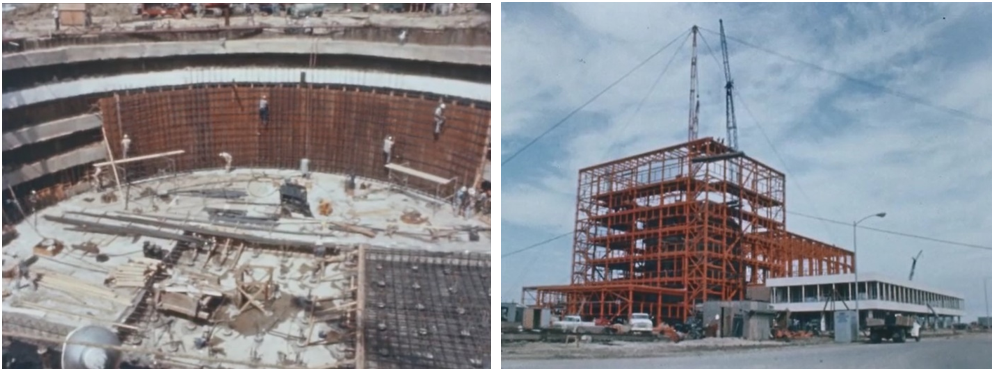
Left: The area of the future Chamber A excavated during the construction of the Space Environment Simulation Laboratory in Building 32 in late 1963. Right: Building 32 under construction in March 1964, with Chamber A visible through the steel infrastructure. Credits: NASA
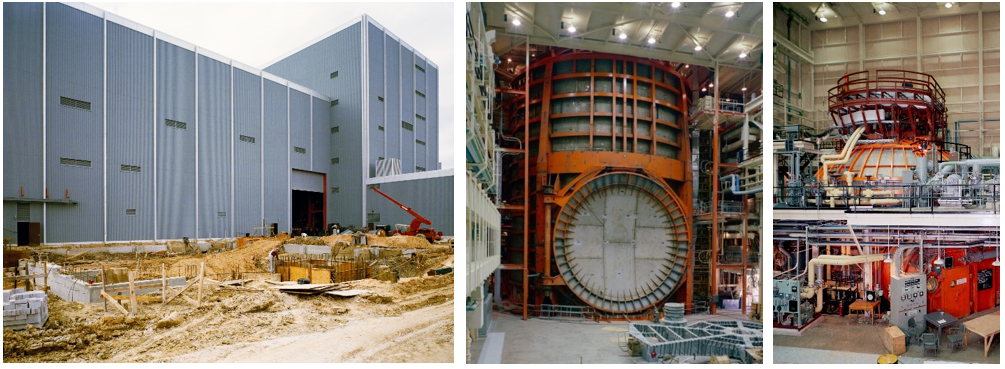
Left: Exterior view of Building 32 as construction neared completion in December 1964. Middle: Chamber A of the SESL in December 1965. Right: The SESL’s Chamber B in August 1965. Credits: NASA
The larger of the two chambers, called Chamber A, measured 90 feet in height and 55 feet in diameter — more than adequate to accommodate the full Apollo spacecraft it was designed to test. Inside the cavernous chamber, a 45-foot “lunar plane” platform could handle a 150,000-pound test vehicle and was capable of rotating 180 degrees to simulate a spacecraft flying to the Moon. The chamber’s vacuum pumps could simulate an altitude of 130 miles.
To simulate the temperature extremes of space, the chamber’s interior walls cooled to -230 degrees Fahrenheit, while two banks of carbon-arc modules simulated the unfiltered heat and light of the sun. Test articles could be placed in the chamber either through a removable top head or a 40-foot-wide side-mounted access door.
The smaller Chamber B, 26 feet high and 25 feet in diameter, had similar capabilities to the larger chamber regarding environmental parameters, but accommodated smaller test articles more economically.
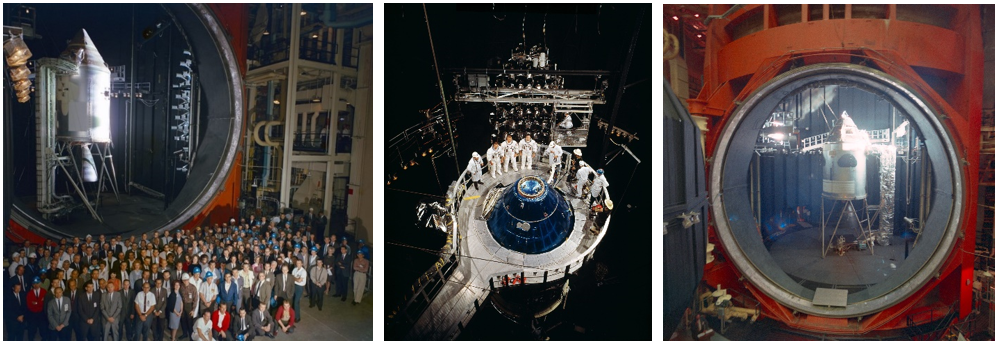
Left: The team poses in front of Chamber A where they tested the Block I Apollo Command and Service Module-008 (CSM-008) in August 1966. (Note the bank of solar simulators to the right of the spacecraft.) Middle: Astronauts Joe H. Engle, left, Vance D. Brand, and Joseph P. Kerwin stand with test engineers behind the Block II 2TV-1 Command Module prior to the June 1968 thermo-vacuum test in Chamber A. (Note the bank of solar simulators behind them.) Right: The 2TV-1 spacecraft in Chamber A for the September 1968 test under lunar spaceflight conditions. Credits: NASA
On May 20, 1964, during the first pump-down test of Chamber A, the facility suffered structural damage that required a redesign and repair of the chamber before it passed acceptance tests in April 1965. In preparation for the first crewed Apollo mission, workers installed the Block I Apollo Command and Service Module-008 (CSM-008) into Chamber in A in May 1966, conducting the first crewed thermo-vacuum test in August. Three non-astronaut test subjects completed the eight-day test. A second test lasted six days, concluding on Nov. 1. It included astronauts Joseph P. Kerwin and Edward G. Givens and test engineer Joseph A. Gagliano.
The Apollo 1 fire in January 1967 temporarily halted testing as engineers redesigned the spacecraft, resuming in 1968 using the Block II 2TV-1 version simulating the Apollo 7 Earth-orbital configuration. Astronauts Kerwin, Vance D. Brand, and Joe H. Engle successfully completed an eight-day test on June 24, 1968 — four months before the Apollo 7 mission. In September, three test subjects completed a five-day test with the spacecraft and test parameters modified to simulate a lunar mission three months before the flight of Apollo 8. These tests demonstrated the integrity of the Apollo spacecraft, especially its hatch, which had been redesigned after the Apollo 1 fire.
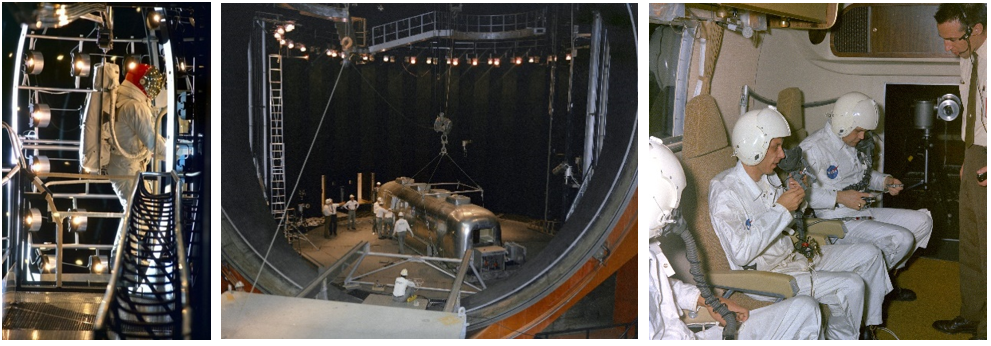
Left: Apollo 9 astronaut Russell L. Schweickart tests his spacesuit in Chamber A in December 1968. Middle: Engineers prepare a Mobile Quarantine Facility (MQF) for vacuum testing in Chamber A in February 1969. Right: Three of the six test subjects who participated in the vacuum testing, including Flight Surgeon Dr. William R. Carpentier, center, who, four months later, joined the Apollo 11 crew for their 21-day postflight quarantine inside a similar MQF aboard the U.S.S. Hornet. Credits: NASA
In December 1968, the Apollo 9 astronauts tested their spacesuits in Chamber A prior to the spacewalks on their mission three months later. Engineers tested a Mobile Quarantine Facility (MQF), part of the postflight quarantine for astronauts returning from the Moon, in Chamber A in February 1969. The altitude tests including subjects inside the MQF tested the emergency oxygen system needed in case of emergency depressurization of the aircraft transporting the unit back to MSC. One of the test participants, Flight Surgeon Dr. William R. Carpentier, four months later joined the Apollo 11 crew in quarantine inside another MQF during their return to MSC following their Moon-landing mission.

Left: The Skylab Apollo Telescope Mount prototype in Chamber A for thermo-vacuum testing in October 1971. Middle left: A test model of the Application Technology Satellite in Chamber A in September 1973. Middle right: A model of the Transhab inflatable module, a precursor to the Bigelow Expandable Activity Module currently linked to the International Space Station, in Chamber A in December 1998. Right: The James Webb Space Telescope emerges from Chamber A in December 2017 following seven months of thermo-vacuum testing. Credits: NASA
Following the end of the Apollo program, engineers modified Chamber A for the testing of other spacecraft components. The 2TV-1 spacecraft was modified and renamed 2TV-2 to simulate the long-duration Skylab missions, testing without a crew in the vacuum chamber in February and March 1971. Engineers tested a prototype of the Skylab space station’s Apollo Telescope Mount (ATM) in October 1971 and the flight ATM in July and August 1972. In September 1973, SESL engineers tested a model of the Application Technology Satellite for NASA’s Goddard Space Flight Center in Greenbelt, Maryland, to verify that its 30-foot diameter umbrella-shaped antenna could unfold in the vacuum of space. Because of the space shuttle’s large overall size, only certain components, such as its active thermal control system, could be tested in Chamber A. For this reason, as well as cost considerations, NASA elected to deactivate the SESL in 1982.
For its historic value in helping the nation attain the Moon-landing goal, in 1985 the facility was added to the National Register of Historic Places. Following the January 1986 Challenger accident, in 1988 NASA elected to reactivate SESL to resume testing of spacesuits and spacecraft components. In December 1998, Chamber A saw the testing of the inflatable Transhab module, a precursor of the Bigelow Expandable Activity Module currently attached to the International Space Station. In 2017, engineers modified Chamber A to accommodate thermo-vacuum testing of the James Webb Space Telescope between May and December of that year.
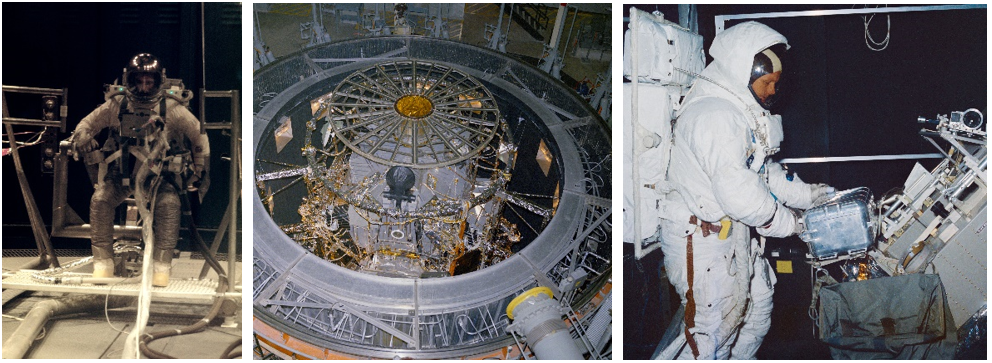
Left: Gemini 9 astronaut Eugene A. Cernan tests the Astronaut Maneuvering Unit in Chamber B in February 1966. Middle: Lunar Module Test Article-8 (LTA-8) in Chamber B in May 1968. Right: Apollo 11 astronaut Neil A. Armstrong deploys lunar surface experiments under space vacuum conditions in Chamber B in April 1969. Credits: NASA
Chamber B passed its initial acceptance tests in June 1964, but upgrades to its solar illumination system required strengthening of the vessel, delaying its first operations to the following year. Testing of Gemini spacesuits in Chamber B began in December 1965, with astronaut Charles A. Bassett becoming the first astronaut to conduct a thermo-vacuum test in the facility. Several astronauts assigned to later Gemini missions carried out tests in Chamber B, including of the Astronaut Maneuvering Unit. After the end of the Gemini program in November 1966, the chamber turned to testing Apollo hardware and spacesuits. Thermo-vacuum testing of the Apollo Lunar Module (LM) began in September 1967 using the LM Test Article-8 (LTA-8), with crewed tests conducted in May and June 1968 to support Earth-orbital missions and in October and November 1968 for lunar missions. Beginning in May 1969, Apollo Moon-landing astronauts practiced deploying experiments while wearing spacesuits in Chamber B’s thermo-vacuum environment. These tests contributed to the success of the Apollo Moon landings.

Left: The Docking Module for the Apollo-Soyuz Test Project undergoes thermo-vacuum testing in Chamber B in September 1974. Middle left: STS-41B astronaut Robert L. Stewart tests shuttle hardware in Chamber B in November 1983. Middle right: The Wake Shield Facility shuttle payload during thermo-vacuum testing in 1993, prior to its flight on STS-60. Right: In July 2016, a test subject evaluates a prototype future spacesuit in Chamber B. Credits: NASA
After the end of the Apollo lunar-landing program, engineers continued to use Chamber B to support NASA’s ongoing human spaceflight programs, such as testing of Skylab spacesuits in April 1972. In 1974, they tested the Docking Module for the Apollo-Soyuz Test Project, the first joint crewed mission between the United States and the Soviet Union. After the reactivation of SESL in 1988, Chamber B supported testing of space shuttle and space station hardware, payloads, and spacesuits. Today, it continues to support activities such as testing of prototype spacesuits for possible use in future exploration missions.
Vibration and Acoustic Test Facility
The VATF, located in MSC’s Building 49, was originally designed for the Apollo program to provide a structural testing facility for spacecraft, simulating the vibro-acoustic environment expected during launch ascent into orbit. Construction began in 1964 and was complete by late 1965, with initial tests conducted in 1966.
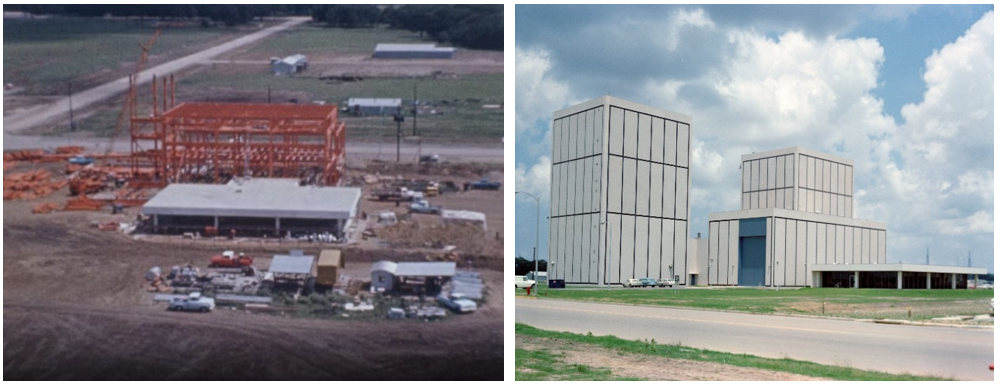
Left: Construction of Building 49 in August 1964. Right: Construction of Building 49 nearly complete in June 1965. Credits: NASA
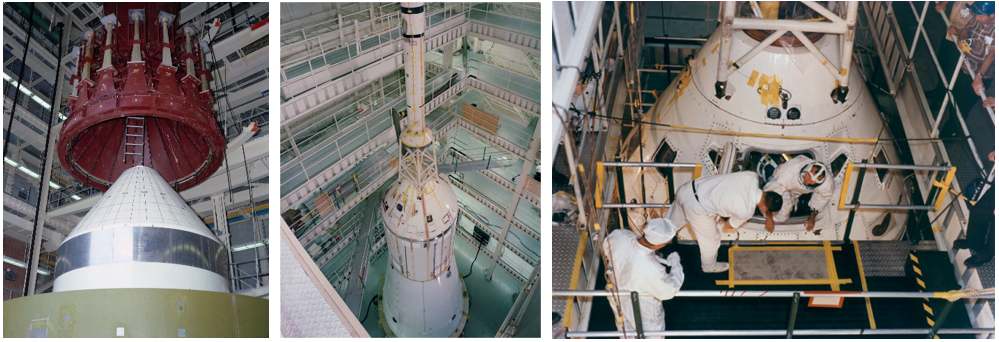
Left: An Apollo boilerplate spacecraft undergoes an acoustic test in Building 49’s Vibration and Acoustic Test Facility (VATF) in May 1966. Middle: A complete Apollo spacecraft following a vibration test in the VATF in February 1968. Right: Astronaut L. Gordon Cooper exits the Apollo Command Module following a low-frequency vibration test in the VATF in February 1968. Credits: NASA
In support of the first crewed Apollo mission, engineers carried out a series of low-frequency vibration tests with Apollo CSM-105 in the VATF in February 1968. Following a series of uncrewed tests, astronaut L. Gordon Cooper, accompanied by two instrumented test mannequins, strapped into the capsule for a test on Feb. 10. The test program demonstrated the structural integrity of the spacecraft wiring, plumbing, secondary structure, and subsystems under simulated aerodynamic noise and vibration stresses expected during launch and powered flight.

Left: In the VATF, astronaut Stuart A. Roosa, left, and two mannequins participate in vibration tests of Apollo Command Module crew couches in April 1968. Middle: LM Test Article-3 (LTA-3) undergoes vibration testing in the VATF in 1966. Right: Drop tests in the VATF with LM-2 in April 1969. Credits: NASA
Engineers tested different models of the LM in the VATF. The LTA-3 underwent a series of vibration tests in 1966. A flight version, LM-2, underwent a series of 16 drop tests between March and May 1969, just two months before the actual first Moon landing, to verify the vehicle could survive a landing under various conditions, and that the ascent stage would be capable of lifting off from the lunar surface. These tests ensured that the various components of the Apollo spacecraft could survive the rigors of launch and landing on the Moon to meet President Kennedy’s goal.

Left: The Skylab payload shroud undergoes vibration testing in the VATF in November 1971. Middle: A space shuttle nose cap is tested in the VATF in 1980. Right: Testing in the VATF of a space shuttle vertical stabilizer in 1980. Credits: NASA

Left: The Wake Shield Facility shuttle payload with astronaut Ronald M. Sega during an October 1991 modal survey test in the VATF before flying on STS-60. Middle: The structural test article (STA) of the space station S0 truss segment during modal testing in the VATF in December 1998. Right: The space station Solar Array Rotary Joint STA during modal testing in the VATF in December 2007. Credits: NASA
Following the end of the Apollo Moon-landing program, the VATF continued to support subsequent space programs. In November 1971, engineers tested the effects of launch vibrations on the Skylab payload shroud mounted on a mock-up of the Orbital Workshop. In 1980, NASA initiated the Orbital Structural Fatigue Test Program to identify structural fatigue in space shuttle components such as orbiter wing leading edges, nose cap, and Orbiter Maneuvering System pods. The facility conducted modal testing on space shuttle payloads, such as the Wake Shield Facility, and on space station components such as truss elements and the Solar Array Rotary Joint. Today, the VATF continues to support vibro-acoustic testing of space and non-space hardware.
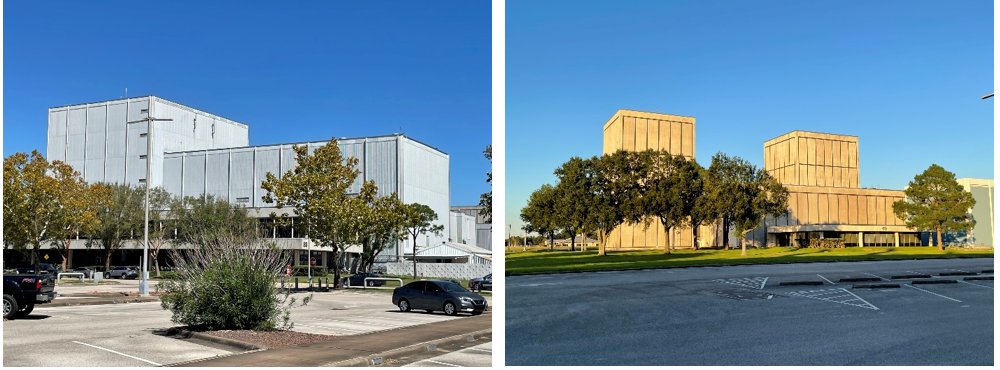
Left: The SESL in Building 32 in October 2021. Right: The VATF in Building 49 in October 2021. Credits: NASA
To be continued …







